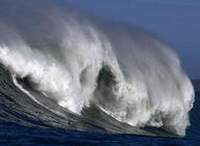United States' Atlantic Coast prepares for killer waves
Standing outside his home 100 meters from the Atlantic Ocean, John T. Woods III has a hard time imagining it - a towering tidal wave one day crashing over the dock where a lone fisherman casts his line for trout.

Yet emergency managers here in Liberty County soon plan to post a warning sign near Woods' house depicting a stick man running uphill from a monstrous wave and declaring the surrounding area as a "Tsunami Hazard Zone."
The closest thing that Woods, a lifelong Georgia coast resident, has seen to a natural disaster was Hurricane David, a Category 2 storm in 1979 that caused no devastation. Tsunamis, he says, "have never been a factor."
"I really think it's a waste of time," said the 47-year-old shrimper. "But you never know."
While tsunamis are primarily considered a threat on the Pacific Coast, emergency officials are paying closer attention to the potential for killer waves on the United States' Atlantic Coast since the 2004 Indian Ocean tsunami that killed more than 200,000 people in 11 countries.
The government's West Coast and Alaska Tsunami Warning Center now watches out for the East Coast as well. A tsunami-detection buoy monitors for sudden changes in sea level 320 miles (515 kilometers) off Charleston, South Carolina.
And a few local governments along the East Coast, including Georgia's Liberty County, have enrolled in a National Weather Service program to prepare for the remote chance of killer waves spawning in the Atlantic.
"There is a possibility, though a very slight possibility," said Tom Burris, emergency management director for Liberty County. "Just like a hurricane, you can talk until you're blue in the face and people will say it ain't going to happen here."
On Jan. 9, Liberty County became only the ninth community on the U.S. eastern seaboard to be certified by the Weather Service as officially ready to respond to tsunamis, tidal waves caused by earthquakes or rock slides under the sea.
Also certified as tsunami-ready are Indian Harbour Beach, Florida; Onslow County, North Carolina; Norfolk, Virginia; and five South Carolina communities - Charleston County, Horry County, Myrtle Beach, North Myrtle Beach and Surfside Beach.
"After the tsunami hit Indonesia in 2004, it really became important that, jeez, it may be a rare event, but that doesn't mean we shouldn't be prepared for it," said Paul Yura, warning coordination meteorologist for the Weather Service in Charleston, South Carolina.
The budget for the TsunamiReady program was $750,000 (EUR 576,000) in fiscal 2006. Rather than build up seawalls or fortify existing infrastructure, it aims to set minimum standards to prepare local governments to evacuate people during tsunami warnings.
Emergency managers receive no special training other than a briefing from the Weather Service on tsunami threats. The most intensive part is mapping which portions of a city or county are vulnerable to flooding by tsunami waves.
Not everybody took it seriously when Indian Harbour Beach, a city of 8,700 located 70 miles (115 kilometers) southeast of Orlando, was named the first tsunami-ready city on the Atlantic in 2005. Officials there spent about $500 (EUR 385) on extra megaphones to use for evacuations and a flashing warning light and sign to post on the beach.
Pranksters would steal the Florida city's beachside tsunami warning signs almost as soon as the signs are posted, likely coveting them as novelty souvenirs, City Manager Jackie Burns said.
"A couple of the other cities laughed at us," Burns said. "But hey, whatever you can do to protect your people. And I think people want to feel protected since Sept. 11. It's just an unsettling time for people."
According to the National Geophysical Data Center, seven tsunamis have been recorded in Atlantic and Gulf Coast states since 1886 - when large waves followed earthquakes that struck Charleston, South Carolina, and Jacksonville, Florida, on the same day. No Americans died in the seven tsunamis, and most produced waves so small they could barely be detected.
Geologists say an Atlantic Coast tsunami could be triggered by the breaking of old fault lines offshore or by inland earthquakes causing an undersea landslide of sediments piled where the shallow continental shelf drops sharply into the ocean, the AP reports.
What is not known is how often such events might produce powerful tsunamis in the Atlantic - recorded history does not reach back far enough, said Martitia Tuttle, a geologist in Georgetown, Maine. Tuttle studies underground deposits of sand, pebbles and other deposits swept ashore by tsunamis hundreds or even thousands of years ago.
"You want to get an idea of recurrence," Tuttle said. "If these large events occur, let's say, every 2,000 years, you have to go back more than that to get an idea of the repeat time."
Subscribe to Pravda.Ru Telegram channel, Facebook, RSS!




